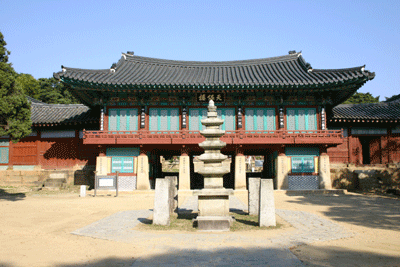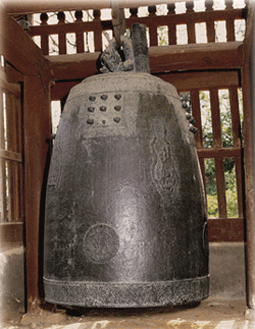Yongjusa is a head temple of the Jogye Order of Korean Buddhism. It is located in on the slopes of Hwasan in Taean-eup, Hwaseong, in the province of Gyeonggi, South Korea. The temple’s name means “dragon jewel temple.”
Two large bells in the temple are believed to date to the Unified Silla period. One of them is designated national treasure 120.
Yongjusa is the result of a son’s longing for his dead father and a tribute to filial piety. When the father of King Chongjo (r. 1776-1800) died, the king could not forget him. Some time passed and then, one day, he heard a lecture on the Parental Benevolence Sutra, a text which explains the debt that children have to their parents. He decided to rebuild Kalyangsa on memory of his father and move his father’s tomb there.
Originally the temple had been constructed by Master Yomgu in 854 CE and then greatly enlargedin 952. Even though the temple is not in the mountains, it bestows a sense of peace and well-being on those who enter its gates.
The name of the temple, as is so often the case, comes from a legend. On the night before the day of the completion of the building activities, King Chongjo dreamed of a dragon soaring up into the sky inside Yongjusa and there receiving the Pearl of Truth, the Wish-Fulfilling Gem. (This is the ball that most dragons carry in their mouths.) Therefore the temple came to be called Dragon’s Pearl of Truth Temple.
Dragons are auspicious animals with divine properties. Considered a symbol of regal authority, the dragon was also thought to dispel evil spirits. Dragons are usually related to heaven and water and are used in rituals involving rain. Considered protectors, they have always been seen as important in protecting Korea from invasion and so there are many legends about sea dragons who defend the peninsula.
King Munmu wished to be reborn as a great dragon to protect his country and so he was buried under a large rock in the sea off the east coast. The kings of the family who founded the Koryo Dynasty were all reputed to be descendants of the Divine Sea Dragon and each one of the family had a dragon scale in his or her armpit.
In 1911 the temple was made one of the 24 main temples of the Korean Buddhist Chogye Order.
The copper bell of Yongjusa is very special. It is presumed to have been cast in the early 10th century, during the Koryo Dynasty, because of the style of the dragon. Shilla bells have a dragon holding the bell with two legs. In Yongjusa, the dragon is holding the bell up with just one leg.
Behind the hall, there is an unusual five-story stupa dedicated to Ksitigarbha, the Bodhisattva who helps those in trouble. It has a small wooden sign with the names of the donors on it. This stupa was also built for King Chongjo’s father.
Phone: 031-234-0040
Web: www.yongjoosa.or.kr






